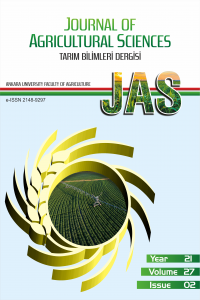Effects of Biofloc Technology (BFT) on Growth of Speckled Shrimp (Metapenaeus monoceros)
Effects of Biofloc Technology (BFT) on Growth of Speckled Shrimp (Metapenaeus monoceros)
Corn starch, glycerol, growth, histology, mannan-oligosaccharides, Metapenaeus monoceros,
___
- Anand PSS, Kohli MPS, Kumar S, Sundaray JK, Roy SD, Venkateshwarlu G, Sinha A & Pailan GH (2014). Effect of dietary supplementation of biofloc on growth performance and digestive enzyme activities in Penaeus monodon. Aquaculture 418, 108115.
- APHA (1998). Standard Methods for the Examination of the Water and Wastewater, 22nd edn. American Public Health Association, Washington, DC.
- APHA (2005). Standard methods for the examination of water and wastewater, American Public Health Association, Washington.
- de Paiva Maia E, Alves Modesto G, Otavio Brito L, Olivera Galvez A & Vasconcelos Gesteira TC (2016). Intensive culture system of Litopenaeus vannamei in commercial ponds with zero water exchange and addition of molasses and probiotics. Revista de Biología Marina y Oceanografía 51(1), 61-67.
- Emerenciano M, Ballester EL, Cavalli RO & Wasielesky W (2011). Effect of biofloc technology (BFT) on the early postlarval stage of pink shrimp Farfantepenaeus paulensis: growth performance, floc composition and salinity stress tolerance. Aquaculture International 19(5), 891-901 http://dx.doi.org/10.1007/s10499-010-9408-6.
- Emerenciano M, Ballester EL, Cavalli RO & Wasielesky W (2012). Biofloc technology application as a food source in a limited water exchange nursery system for pink shrimp Farfantepenaeus brasiliensis (Latreille, 1817). Aquaculture research, 43(3), 447-457. http://dx.doi.org/10.1111/j.1365-2109.2011.02848.x
- Emerenciano M, Gaxiola G & Cuzon G (2013). Biofloc technology (BFT): a review for aquaculture application and animal food industry. In Biomass now-cultivation and utilization. InTech.
- Genc MA, Aktas M, Genc E & Yilmaz E (2007). Effects of dietary mannan oligosaccharide on growth, body composition and hepatopancreas histology of Penaeus semisulcatus (de Haan 1844). Aquaculture Nutrition, 13(2), 156-161. http://dx.doi.org/10.1111/j.1365-2095.2007.00469.x.
- Hopkins JS, Hamilton RD, Sandifer PA, Browdy CL & Stokes AD (1993). Effect of water exchange rates on production, water quality, effluent characteristics and nitrogen budget in intensive shrimp ponds. Journal of the World Aquaculture Society, 24, 304-320.
- Jackson AJ (2007). Challenges and opportunities for the fishmeal and fish oil industry. Feed Technology Update, 2(1), 9.
- Johnson PT (1980). Histology of the Blue Crab, Callinectes sapidus. A model for the Decapoda. Praeger, New York, 440 pp.
- Kaya D & Genc E (2018). Biofloc technology in aquaculture. Su Urunleri Dergisi (Ege Journal of Fisheries and Aquatic Sciences), 35(2), 1-1. http://www.egejfas.org/issue/35874/391890
- Krummenauer D, Peixoto S, Cavalli RO, Poersch LH & Wasielesky W (2011). Superintensive culture of white shrimp, Litopenaeus vannamei, in a biofloc technology system in southern Brazil at different stocking densities. Journal of the World Aquaculture Society, 42(5), 726-733. http://dx.doi.org/10.1111/j.1749-7345.2011.00507.x.
- Kuhn DD, Lawrence AL, Boardman GD, Patnaik S, Marsh L & Flick Jr GJ (2010). Evaluation of two types of bioflocs derived from biological treatment of fish effluent as feed ingredients for Pacific white shrimp, Litopenaeus vannamei. Aquaculture, 303(1-4), 28-33. http://dx.doi.org/10.1016/j.aquaculture.2010.03.001.
- Kumar S, Anand PSS, De D, Deo AD, Ghoshal TK, Sundaray JK, Biswas G & Lalitha N (2017). Effects of biofloc under different carbon sources and protein levels on water quality, growth performance and immune responses in black tiger shrimp Penaeus monodon (Fabricius, 1978). Aquaculture Research, 48(3), 1168-1182. http://dx.doi.org/10.1111/are.12958.
- Lara G, Krummenauer D, Abreu PC, Poersch LH & Wasielesky W (2017). The use of different aerators on Litopenaeus vannamei biofloc culture system: effects on water quality, shrimp growth and biofloc composition. Aquaculture International, 25(1), 147-162. http://dx.doi.org/10.1007/s10499-016-0019-8.
- Mishra JK, Samocha TM, Patnaik S, Speed M, Gandy RL & Ali AM (2008). Performance of an intensive nursery system for the Pacific white shrimp, Litopenaeus vannamei, under limited discharge condition. Aquacultural engineering, 38(1), 2-15.
- Moss SM, Pruder GD & Samocha TM (1999). Environmental management and control: controlled ecosystem and biosecure shrimp grow-out systems. In: Bullis RA, Pruder GD (eds) Controlled and biosecure production systems, preliminary proceedings of a special integration of shrimp and chicken models. World Aquaculture Society, Sydney, Australia, 87-91.
- Rahman SHA, Razek FAA, Goda AMA-S, Ghobashy AFA, Taha SM & Khafagy AR (2010). Partial substitution of dietary fish meal with soybean meal for speckled shrimp, Metapenaeus monoceros (Fabricius, 1798) (Decapoda: Penaeidae) juvenile. Aquaculture Research, 41(9) 299-306. http://dx.doi.org/10.1111/j.1365-2109.2010.02530.x
- Wang JK (1990). Managing shrimp pond water to reduce discharge problems. Aquaculture Engineering, 9:61-73.
- Xu WJ & Pan LQ (2012). Effects of bioflocs on growth performance, digestive enzyme activity and body composition of juvenile Litopenaeus vannamei in zero-water exchange tanks manipulating C/N ratio in feed. Aquaculture, 356, 147-152. http://dx.doi.org/10.1016/j.aquaculture.2012.05.022.
- ISSN: 1300-7580
- Yayın Aralığı: Yılda 4 Sayı
- Başlangıç: 1995
- Yayıncı: Ankara Üniversitesi
Production of Multiple Hydrolytic Enzymes by Black Aspergilli Isolated from Date and Grape
Zehra GULSUNOGLU, Meral KİLİC-AKYİLMAZ, Funda KARBANCİOGLU-GULER, Katleen RAES
Birce TABAN, Meltem COLAKLAR, Sait Aykut AYTAC, Hamdi Barbaros ÖZER, Ayse GURSOY, Nefise AKCELİK
Effects of Biofloc Technology (BFT) on Growth of Speckled Shrimp (Metapenaeus monoceros)
Doğukan KAYA, Münevver Ayçe GENÇ, Mevlüt AKTAŞ, Orhan Tufan EROLDOĞAN, Farah Gönül AYDIN, Ercüment GENÇ
House Dust Mite Species in Ordu, Turkey
Rana AKYAZI, Mete SOYSAL, Pavel B. KLİMOV, Yunus Emre ALTUNÇ
Rade STANİSAVLJEVİĆ, Jasmina KNEŽEVİĆ, Dalibor TOMİĆ, Dražen JOVANOVİĆ, Nadica TMUŠİĆ, Ratibor ŠTRBANOVİĆ, Dobrivoj POŠTİĆ
Etlik Piliçlerde Yeme İlave Edilen Zeytin Yaprağının Göğüs Eti Kalitesi Üzerine Etkisi
İsmail YAVAŞ, Hatice BASMACIOĞLU MALAYOĞLU
Melike BAKIR, Hatice DUMANOĞLU, Veli ERDOĞAN, Cemil ERNİM, Tahir MACİT
Modelling Indoor Environmental Conditions in a Commercial Broiler House
Ticari Soğan Çeşitlerinin Soğan Sak Nematodu Ditylenchus dipsaci’ ye dayanıklılık ve toleransları
Yousef ABBASPOUR-GİLANDEH, Sajad SABZİ, Juan IGNACİO ARRİBAS
